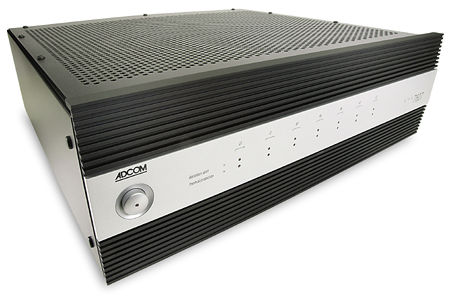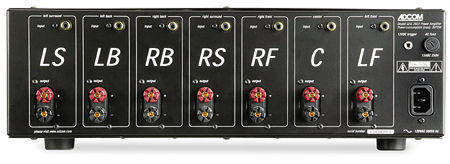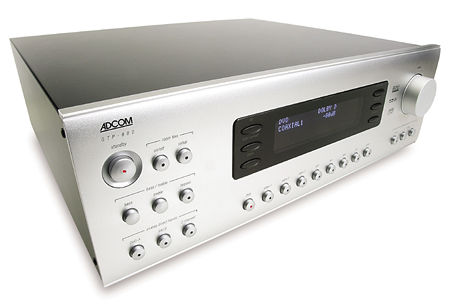Adcom GTP-880 preamp-processor & GFA-7607 multichannel power amplifier
Now a division of Klein Technology Group and based in Scottsdale, Arizona, Adcom has also jumped into home theater in a big way. The company offers four combination tuner-preamp-surround processors and seven multichannel amplifiers. I recently took the GFA-880 pre-pro and GFA-7607 amp for an extended test drive. Priced at approximately $2300 and $1900, respectively, the Adcoms together occupy a market niche above many home-theater receivers but below most high-end separates.
GFA-7607 Power Amplifier
The GFA-7607 is a 7-channel power amplifier that delivers 125Wpc into 8ohms or 175Wpc into 4ohms. Adcom hasn't blown its budget—and won't blow yours—with a thick, engraved faceplate. Instead, there's a minimalist, two-tone front panel with a Power button and indicator LEDs. The chassis's other surfaces are unadorned black. The rear panel is the essence of simplicity, with seven widely spaced, gold-plated RCA jacks above pairs of standard dual five-way binding posts, and an IEC socket for the power cord. There's no provision for balanced inputs. For ease of installation, each channel is marked in large white letters: LF, RF, C, etc. The output jacks are far enough apart that there's no danger of accidentally shorting a channel when hooking up speakers, even when biwiring with heavy cables.

Inside, a hefty toroidal power transformer resides just behind the front panel. Seven identical amplifier modules with integrated heatsinks, arrayed in vertical rows, occupy most of the 7607's interior. The transformer supplies raw AC to each module, which has its own onboard DC power supply with filtering provided by a pair of compact, 10,000µF/63V capacitors. Output from each module is via four matched, high-current transistors.
The GFA-7607 went into my system as a temporary replacement for the Parasound Halo A 51, reviewed in the October 2003 issue. Starting cold, the amp's dynamics and big-bass capability were immediately impressive. Initially, it seemed to favor the mid- to lower bass region, with a somewhat recessed presentation of the midrange and treble. As it warmed up, the mids and top end became more coherent and better focused. Once the 7607 reached a stable operating temperature—about 30 minutes into the first listening session—its sonic signature coalesced, revealing cleanly defined mid frequencies, extended treble with just a hint of "bite," and a full-throttle bottom end ideally suited for action movies. The battle sequences in Star Trek: Nemesis literally shook the walls, and the rapping-on-the-glass sound effects in Finding Nemo almost jolted a couple of guests from their seats.
Although it lacked the ultimate refinement of the Parasound Halo A 51—it's half the price and half the power—the GFA-7607 was quite satisfying with music, too, especially with such material as A Mighty Wind and Diana Krall Live in Paris. It delivered the goods during occasional high-volume rock attacks and late-night jazz-combo reveries. Only during rare music-only listening sessions was I aware that it wasn't offering the Halo's level of soulfulness or transparency. With movies, the Adcom seemed up to any task, never faltering, never drawing attention to itself for any sonic deficiency. Dialog, sound effects, and music all came through clearly, and with a dynamic impact that amazed me the entire time.

The GFA-7607's enormous bass capability remained something of a mystery—unless the bench tests reveal otherwise, I have to assume that the amp is designed to measure flat in sweep-tone tests into load resistors. In actual use, it performed like something much more powerful than its specs would indicate. No matter how hard I pushed it, it never seemed to run out of breath.
Most home theater systems using speakers with any sane degree of input sensitivity will find 125Wpc more than adequate, and seven channels of 125W each in a relatively compact package offer a lot of versatility. For example, the GFA-7607 is all the amp you'll need for a full 7.1-channel surround system—with the addition of a subwoofer, of course. Or it could power a 5.1 system while the two remaining channels drive speakers in a second zone. Or you could biamp your left and right front speakers by putting Y-adapters on the inputs of two pairs of channels, making 250W of power available to those speakers, and still have 125Wpc available for front center and surrounds. A pair of 7607s would be ideal to power an elaborate whole-house audio system, an application that almost certainly was one of the design parameters.
Moderate ventilation seemed to be all the GFA-7607 needed; even run hard for several hours, it never got hot. While it's not the ultimate in audiophile terms, it's ideal for home theater systems built on moderate budgets, or for whole-house music systems in which clarity, dynamics, and reliability are more important than the resolution of delicate musical textures.
GTP-880 Tuner-Preamplifier-Processor
Approximately the size of a moderately powered receiver, the GTP-880 preamp-processor is much more of a looker than the GFA-7607 power amp. It's actually almost pretty, in a no-nonsense way. Up front is a cleanly designed satin aluminum panel, with input selection and function buttons logically arrayed beside and beneath a rectangular black window housing a blue alphanumeric display flanked by six black buttons for tuner functions and memory presets. On the right side of the front panel, above three buttons to select the surround mode, is a large Volume knob. The rest of the chassis is finished in semigloss black enamel. It's an inviting, easy-to-use design that looks right at home among other gear sporting the trendy silver-and-blue motif.

The GTP-880's rear panel includes gold-plated RCA connectors for composite video and 2-channel audio inputs and outputs, three sets of BNC component-video inputs, and one set for component video out. Also present are S-video connectors for each video source, and for the monitor output. In the lower right corner is a master On/Off switch next to an IEC power-cord receptacle. Everything on the rear panel is clearly labeled in white lettering against black, to minimize hookup mistakes. The Room 2 output is 2-channel audio only. An RS-232 port is provided for custom installers or advanced users who want to customize the GTP-880 or integrate it into a fully automated system.
There are two mini jacks for IR input, and two for 12V triggers for the main and Room 2 amps. Digital audio connections include three coax and three optical inputs as well as one of each output. Analog audio inputs include CD, Aux, Tape, and a discrete 5.1 analog input labeled DVD-Audio. Next to these is a three-position toggle switch for analog bass management. Like the GFA-7607, the GTP-880 has no balanced inputs or outputs.
Above the DVD-A inputs is a DB-25 connector labeled SACD, an arrangement I had not previously encountered and that prevents the use of specialty cables. In fact, I don't recall ever seeing an SACD player with a DB-25 output. However, I note in Fred Manteghian's review of the Aragon Stage One pre-pro and 3005 amplifier (SGHT, March/ April 2004) that the Aragon uses this connector for multichannel analog inputs, too. Perhaps this connector is an attempt to save space, although plenty of unused real estate remains on the 880's rear panel. The upside is that the GTP-880 provides two sets of multichannel analog inputs—most pre-pros, including very expensive ones, still offer only one. And breakout cables with a DB-25 connector on one end and six RCA phono plugs on the other are available from a number of specialty cable manufacturers.

Both of these analog-only inputs bypass the GTP-880's digital signal processing, as does the 2 Channel function, selectable in the lower left corner of the front panel. Pure analog capability is a concession to audio purists, but the inclusion of Bass and Treble controls is a concession to practicality. When the Bass or Treble button is pressed, the Volume control temporarily becomes a bass or treble level set, allowing bass or treble to be boosted or cut by as much as 8dB—enough to compensate for almost any gross room or speaker deficiency, but not enough to create total distortion.
Pressing the Bypass button, next to the Treble button, disables the tone controls; the button remains lit as long as the Bypass function is on. So do each of the input and surround-mode selector buttons as well as the Room 2 On/Off and Setup buttons, as long as they're in use. The combination of alphanumeric display and illuminated buttons is intended to let even the most diehard technophobe know exactly what's going on with the GTP-880. Many more expensive processors don't always offer clear information about what they're doing, as any custom installer can verify. Keeping user confusion to a minimum should be a primary goal for every equipment designer. Adcom is to be lauded for this.
- Log in or register to post comments




































































